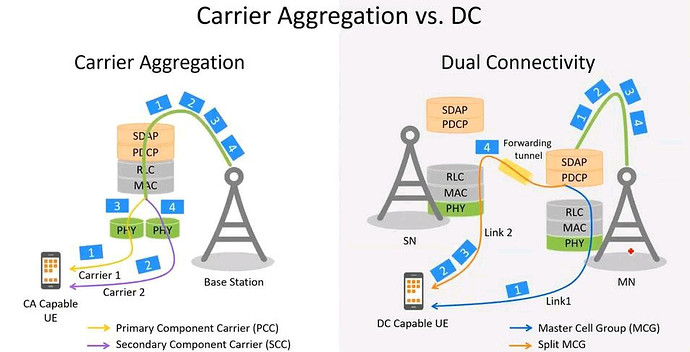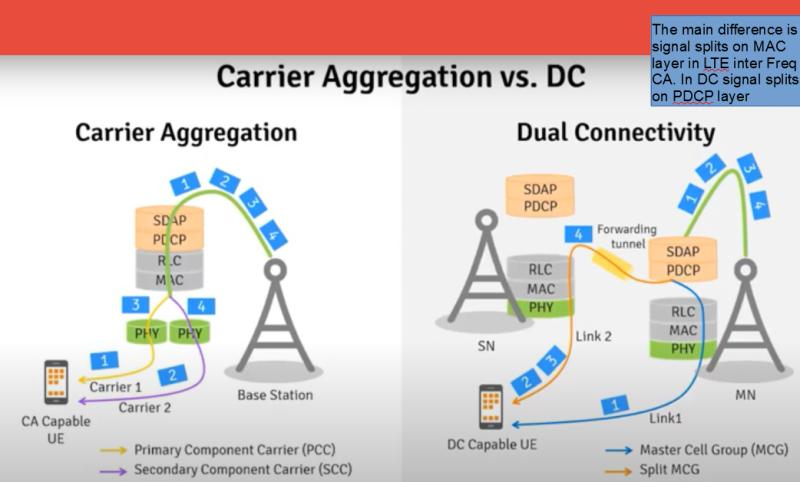Hello Experts,
Whats is the difference between DC and CA?
The differences between CA and DC are as follows:
- In CA all component carriers belong to the same eNodeB, but in DC, the aggregated carriers belong to different cells (where usually one cell is macro and the other is small). That’s why it is sometimes also referred to as inter-site carrier aggregation. The two eNodeBs are referred to as Master Cell Group (MCG) and Secondary Cell Group (SCG). Commonly it’s clear in case of EN DC option 3x
- In CA, only one UE identity is used in all component carriers. But in DC, UE is identified by different C-RNTIs in MCG and SCG.
- Only one PUCCH is used for uplink signaling messages across all component carriers in CA, and it is present in the Primary Component Carrier. In DC, however, separate PUCCHs are used in MCG and SCG.
So, based on the differences we’ve seen so far between CA and DC, we can figure out in which scenario, which aggregation technology would be used.
If the backhaul of the network is ideal between the nodes, then CA can be implemented. But if the backhaul is not ideal, for example, if there are large delays between the nodes, then the choice should be DC.
- Carrier aggregation (CA) allows a UE to simultaneous transmit and receive data on multiple component carriers from a single eNodeB where as Dual Connectivity (DC) allows a UE to simultaneously transmit and receive data on multiple component carriers from two cell groups via master eNodeB (MN) and secondary eNodeB (SN)
- CA can improves peak rates as well as user throughput at low load and DC can increase user throughput, provide mobility robustness, and support load-balancing among eNodeBs
- CA is for the scenarios where the backhaul between nodes is ideal, while DC is for non-ideal backhaul, e.g., relatively large delay between nodes.
- In CA implementation, user traffic is split between carriers in MAC layer, while in DC implementation, it is split in PDCP layer. In DC, the data bearer which is split in PDCP is called split bearer.
- CA and DC are not mutually exclusive; instead, they can be jointly implemented for the same UE e.g, there are multiple carriers in the master cell group (MCG) and multiple carriers in the secondary cell group (SCG)
- A DC UE has two identities: one C-RNTI in MCG and another C-RNTI in SCG, it has an always-active cell in MCG and another always-active cell in SCG, and it has separate PUCCH resource in MCG and SCG. In CA, there is only one common C-RNTI across all component carriers, and there is only one PUCCH which is on PCell.
Reference:
Yes this is right.
Even in LTE we used Dual Connectivity (LTE-LTE inter site CA) where split happen at PDCP layer.
In CA, split happen at Mac layer.
In first diagram, MAC is shown to be common for Pcell and Scell, but actual it is different.
For the Dual Connectivity, it is possible to use SDAP?
If my memory serves me well, DC only for NSA options, and SDAP is only for StandAlone.
Yes, SDAP only for SA.
So is the graph mistaken?
It shows SDAP for MN which I don’t think is correct.
For SN it doesn’t show SDAP which it is OK.
I think it is shown like that because, even though NR network is SA, NSA only UE can use SA network for DC.
Basically SA network can support both SA UE and NSA only UE.
Please correct me if I’m wrong.
Not sure if 5G SA networks can be used by 5G NSA UEs.
I think this is not ENDC since both are gnB. Maybe it is NRDC.
There are different types of dual connectivity
1- DC R12 (MN= LTE, SN = LTE, core = EPC)
2- ENDC (MN= LTE, SN = NR, core = EPC)
3- NGENDC (MN= LTE, SN = NR, core = 5GC)
4- NEDC (MN= NR, SN = LTE, core = 5GC)
5- NRDC (MN= NR, SN = NR, core = 5GC)
SDAP is present when core is 5GC
Ideally it should be able to use, otherwise what NSA devices will do?
I don’t think that 5G NSA UEs have the 5G RRC protocol layer implemented.
Maybe with a software upgrade OTA but probably won’t work for all brands and all models.
It is estimated that over 25 Millions 5G UEs were sold up to now worldwide.
Most of them NSA capable and not SA capable.
Don’t you think for NSA devices, all RRC signalling will be performed through LTE?
And UE do not required to support 5G RRC protocol?
NR will used only for data transmission for NSA devices.
How 5G NSA devices will deal with 5G RRC protocol?
It is not implemented there.
As far as I know 5G SA is totally independent from 4G SO it is impossible that “Don’t you think for NSA devices, all RRC signalling will be performed through LTE”.
Unless there is SRB3, NSA UE may just use LTE RRC and NR RRC messages are all piggybacked.
For SA, it required UE to use NR RRC directly.
Yes may be right.
Question is what NSA UEs will do in SA network then?
I also feel the same.
This is a very tough question fo rover 25 Millions 5G NSA devices on the market.
Probably some will be upgraded OTA but not all brands and not all models.
Anyway, why vendors would do this?
They rather sell new 5G SA phones than to upgrade old ones.

